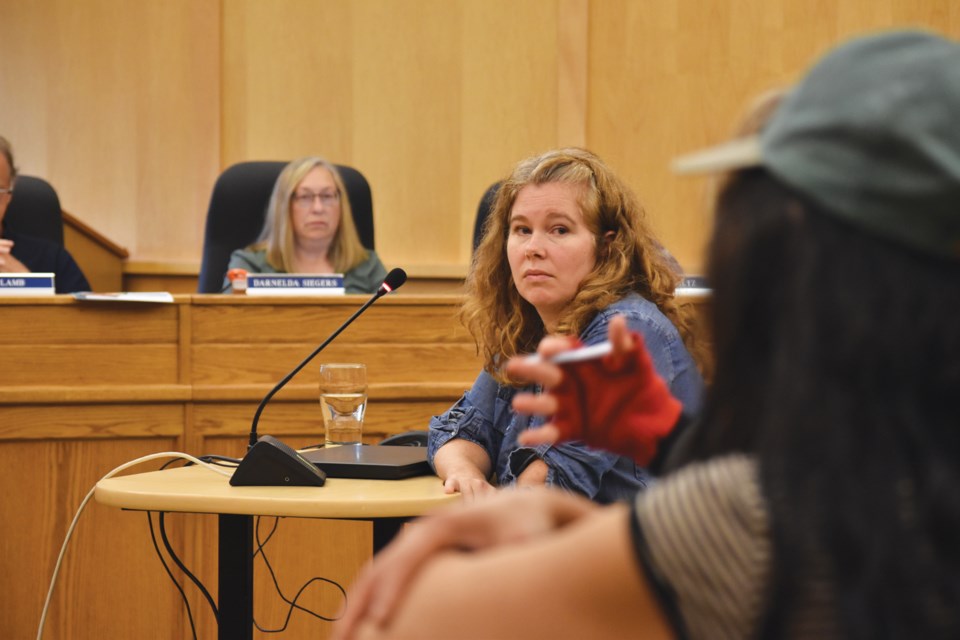A mistake by the Sunshine Coast Regional District (SCRD) planning department has exposed tensions over a semi-rural neighbourhood off Lower Road in Roberts Creek, raising questions about where density belongs and how to plan for affordability.
“This is the Pandora’s box that you SCRD directors and staff are deliberately opening – the piecemeal destruction of Roberts Creek,” said resident Caitlin Hicks at an emotionally charged planning committee meeting Sept. 12.
Hicks was there to express concern over a proposed subdivision neighbouring her home, which she described as an example of “low income seniors housing,” since she rents out a portion of it with her husband to supplement their income – an arrangement in jeopardy because of the subdivision, said Hicks, as it would detract from the rural character of her property.
“If you destroy this neighbourhood with the change of bylaws and our business is reduced by the noise of yet another suburban neighbourhood, we will have to sell and go where?” she said.
But the applicant, Sarah Jacobs, and her young family are also in a precarious financial position. At the meeting she told directors she was forced to apply for an amendment to the zoning bylaw to move ahead with the subdivision because of a mistake made by the SCRD’s planning department. “We triple-checked before we removed subjects and was told the same thing each time,” said Jacobs.
What they were told turned out to be wrong.
The two-acre parcel on Toni Road is surrounded by other residential parcels of varying sizes. Jacobs applied to subdivide it into two residential lots, which are smaller than what is allowed under current zoning and official community plan bylaws, mainly because of sewage disposal considerations and to preserve the “rural ambience” of the area. Thursday’s staff report recommended that since those issues have been addressed, the board should endorse the proposal and a public hearing be scheduled for November. That would clear the way for both lots to support two houses each, rather than the two houses total, currently allowed.
The majority of nearby residents who wrote letters supported the project, as did the Roberts Creek Advisory Planning Commission. Roberts Creek’s OCP committee suggested that it be allowed, but only if one home is built on each lot – an idea Hicks supported.
Before directors voted, they heard from Hicks, and then from Jacobs, who explained why she has been forced to apply for the zoning amendment in the first place.
Before Jacobs committed to the land purchase, SCRD staff wrongly told her on three occasions that the size of the parcel made it eligible to be subdivided. The mistake was only caught after Jacobs had made a deposit on the property. “I didn’t have that money to, poof, disappear,” Jacobs told directors. The only option, she said, was to move ahead with the zoning application since she doesn’t have the resources to sue the SCRD. “It’s already been a two-year process,” she said.
Near the end of the discussion, Gibsons director Bill Beamish asked staff how the error could have happened.
“Staff acknowledge and regret the inconsistent information,” said planning general manager Ian Hall. “Since this instance occurred, staff have put in place a double-check system.”
Hicks argued the proposed subdivision breaches the spirit of Roberts Creek’s Official Community Plan (OCP) to maintain the area’s rural character. “This is exactly what it was created to do, to provide the needed guidance when government is under pressure to develop and densify,” she told directors.
But for Jacobs, the critical matter was the planning department’s mistake. “I’m not some willy-nilly developer who’s coming in. I did my due diligence,” Jacobs told the committee.
Further complicating matters is the fact that another property directly to the south is going through a similar process to be divided into two lots and at the same meeting directors voted unanimously in support of it, clearing the way for it to move ahead to third reading.
Roberts Creek director Andreas Tize said the significant difference between the two proposals was that smaller auxiliary dwellings would be built on the other property, which Tize said would be more affordable than the full-sized houses that could be built in the Jacobs subdivision.
“This has been a bit of an issue,” admitted Tize, adding: “It’s not our community’s goal to become a town.” He, like Hicks, also blamed what he called a vaguely worded amended section of the OCP that encourages densification in areas that already have “some clusters of density” to bring in more affordable housing. He said he wanted more discussions on that new amendment to prevent it from being used “as a tool for wealth creation and densification outside of our core.”
In the end, directors voted to hold off voting on second reading, which would trigger a public hearing, to give Hicks and Jacobs a chance to find common ground and come to an agreement. If they can, and the board supports the proposal, the public hearing could still take place in November.



